Keeping your aquarium clean is vital when it comes to a successful tank.
So it’s natural to want a filter with an excellent filtration process – replacing the nasty bacteria with the good bacteria your fish need to stay happy and healthy.
Hang on the back (HOB) filters are one of the most popular filters, as they’re easy to install, effective, and need little maintenance.
For this review, I bought the Seachem Tidal, Fluval C4, AquaClear, Marineland Penguin, and Tetra Whisper hang-on-back filters to test and review on my tanks to see which one performs best.
TLDR – Top Pick For HOB Filter
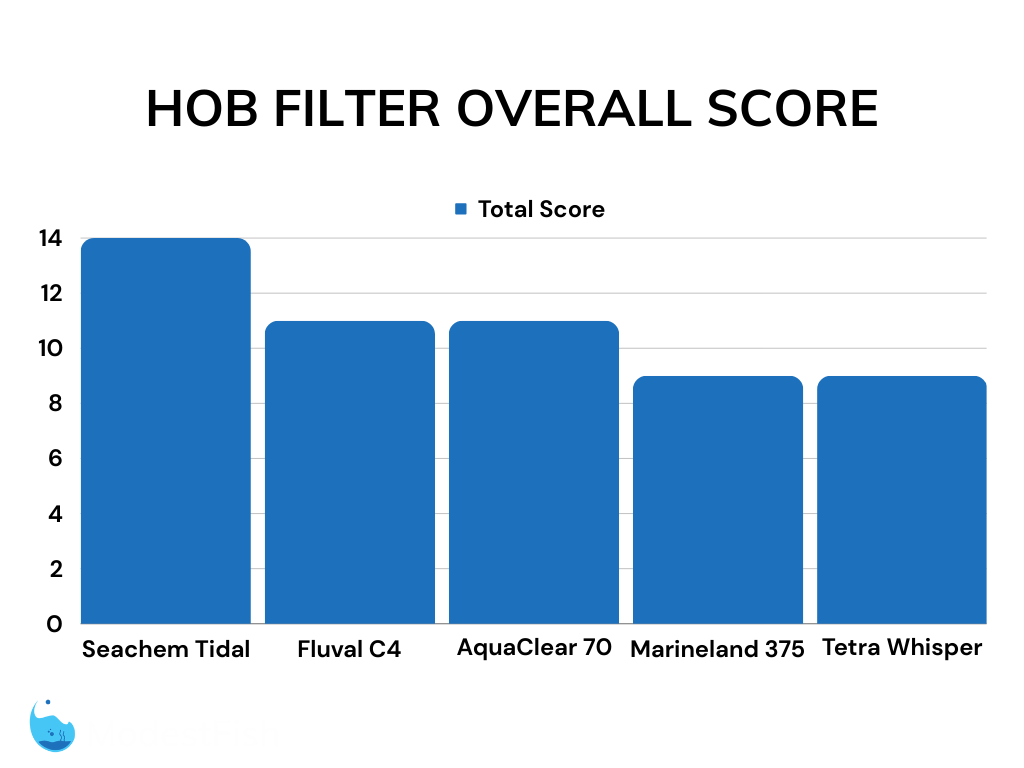
The clear winner of this head-to-head challenge for the best HOB filter is the Seachem Tidal.
- No priming needed
- Huge filter media capacity
- Quiet running
- Easy maintenance
If you are wanting to use one of these for a shrimp tank, I highly recommend getting an AquaClear 70 and adding a sponge pre-filter.
| Preview | Product | |
|---|---|---|

|
SeaChem – Large Aquarium Fish Tank Filter, Tidal 75 Gallon (300 Liters) by Sicce | Buy on Amazon |

|
Fluval C4 Power Filter, Fish Tank Filter for Aquariums up to 70 Gal. | Buy on Amazon |
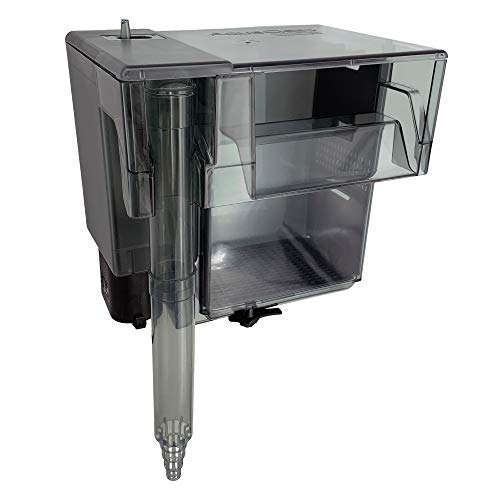
|
AquaClear 70 Power Filter, Fish Tank Filter for 40- to 70-Gallon Aquariums, Black | Buy on Amazon |

|
MarineLand Penguin PRO 375 Power Filter, Multi-Stage Aquarium Filtration for Up to 75 Gallons | Buy on Amazon |

|
Tetra Whisper EX 70 Filter For 45 To 70 Gallon aquariums, Silent Multi-Stage Filtration, WHITE | Buy on Amazon |
Last update on 2024-04-18 / Commissions Earned / Images from Amazon Product Advertising API
How I Tested the HOB Filters for this Article
We purchased five brand new filters. All of the ones we tested for this article are rated for tanks between 55 and 75 gallons (208-284 liters) in an attempt to make the comparison as fair as possible.
But, if your tank is a different size, all of these filters also come in larger or smaller sizes.
We unboxed the filters, set them up per the manufacturer’s instructions and let them run on several of my tanks. It was our goal to run each one through its paces.
Also, I’ve got quite a bit of experience with these filters. I’ve used each one at one point or another over the last few years. So, I’ve got a really good idea of their pros and cons from the perspective of a hobbyist.
All GPH testing was done with brand new filters and filter media to ensure fairness. I didn’t want to use a filter that had build up inside it and have that throw off the test.
I did two different head-to-head comparisons, one for GPH and another that compared features like priming, biomedia space and the filter media included with the filter.
What is GPH and Why is it Important?
GPH (gallons per hour) is the measure of how much water the filter’s motor can pump through the housing each hour. This is an important factor when you’re deciding on which filter to pick for your tank.
It is generally recommended that you use a filter that has a GPH that is at least four times the volume of your tank.
For example, if you have a 20 gallon (76 liter) tank, you would want a filter that has a GPH of at least 80.
This ensures that all of the waste products in the water column will be pumped over the biomedia so that the beneficial bacteria have a chance to eat up all the ammonia and nitrite.
If the GPH is too low, ammonia can build up in the water column because the water it’s in doesn’t get pumped over the biomedia fast enough.
GPH Rating vs. Actual GPH
It’s common for GPH ratings from manufacturers to be different from the actual GPH a filter puts out.
GPH ratings are based on ideal lab conditions that test the pump only, not the whole filter. So, by itself, the motor may be able to pump 600 GPH, but when you add the canister body and filter media, the GPH is reduced.
And GPH will be especially reduced when water is flowing through filter media that has algae and fish waste in it. The more clogged the filter media is, the slower the water flow will be.
GPH Testing
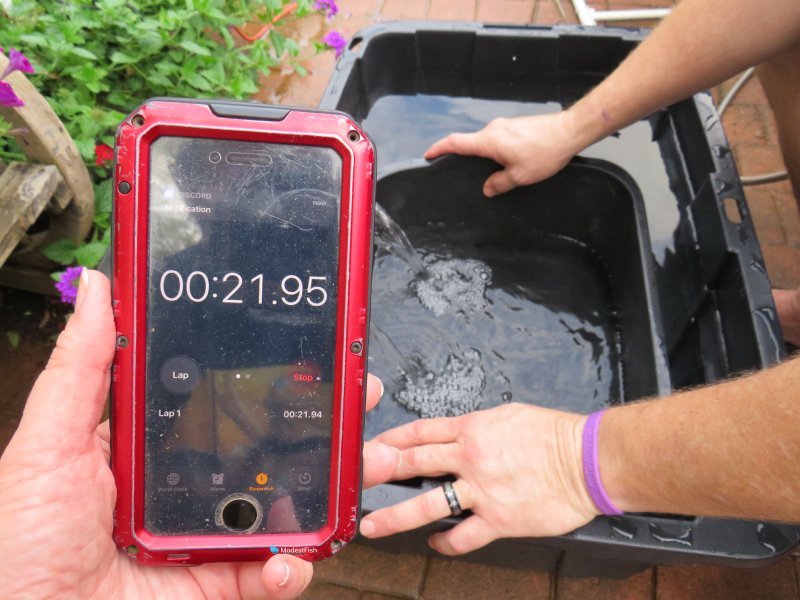
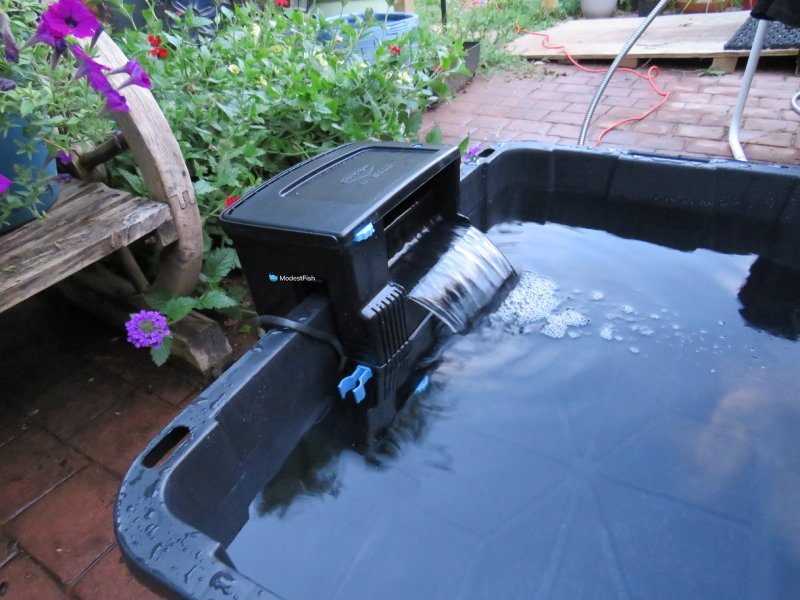
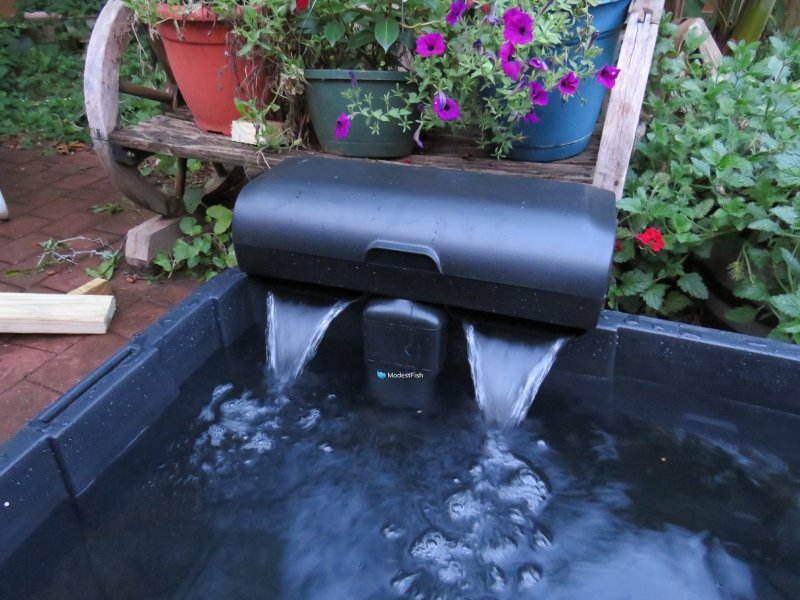
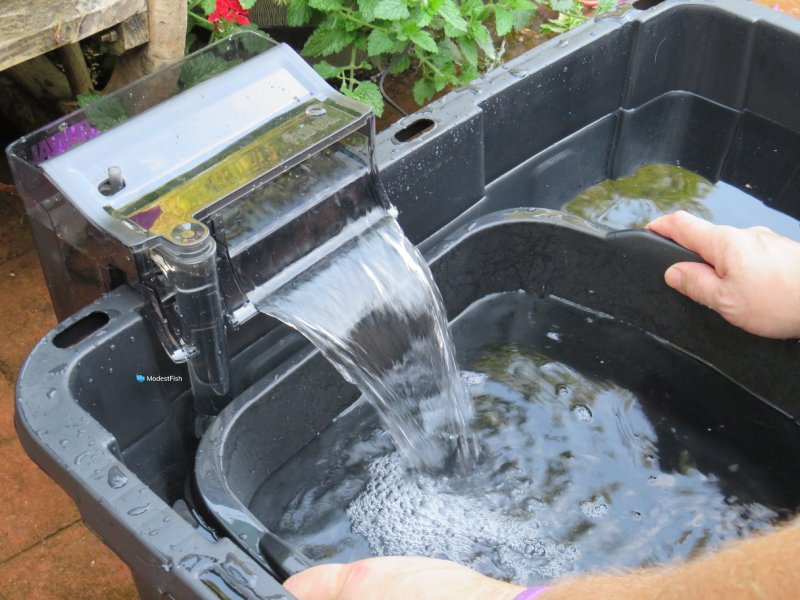
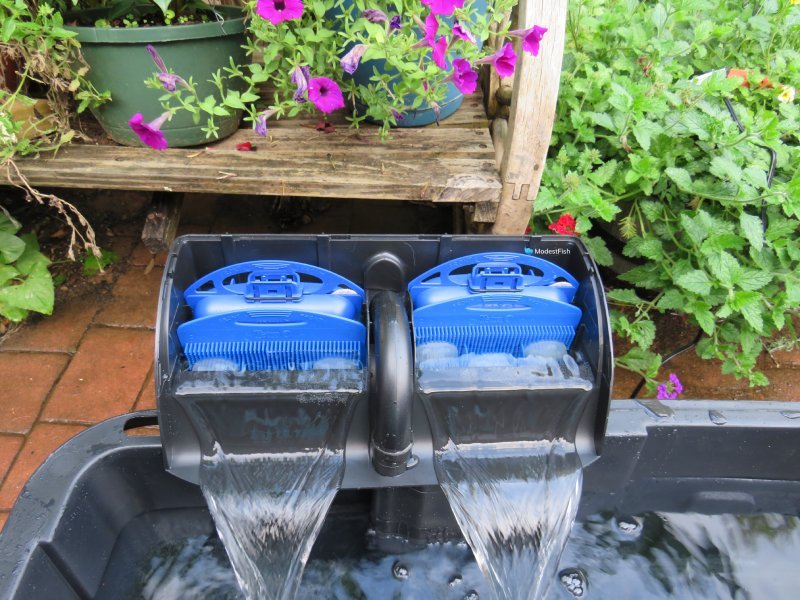
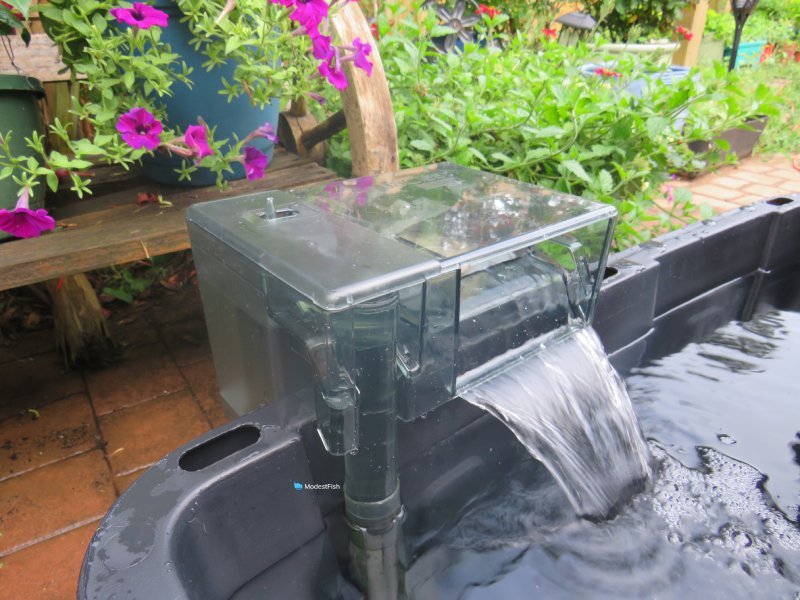
To test the GPH of each filter, we mounted each one on the side of a sturdy plastic storage tote that was filled with water.
We got the filters running and then submerged a 4 gallon (15 liter) container in front of the outflow. We started a stopwatch so could time how long it took the filter to fill up the container.
We did this four times for each filter, twice with no filter media and twice with all of the filter media that was included in the package installed.
I just want to give a quick shoutout to my husband, Steve. He’s helped me do a bunch of these experiments and I wouldn’t have been able to get them done without him. So, thanks babe!
Once we had our data from the experiments, we crunched the numbers.
We converted all the times to seconds since this made the math a little easier.
We took the average time from each category for each filter and divided that by 4, which gave us the gallons per second.
We used that number to divide 3,600, the number of seconds in an hour, to find the gallons per hour.
Here’s an example if the recorded times were 01:30 and 01:15.
That would be 90 seconds and 75 seconds.
(90+75) 2 = 82.5 average time in seconds
82.54 = 20.625 seconds per gallon
360020.625 = 174.55 gallons per hour
These GPH results were taken under optimal conditions with pristine filter media. As algae, detritus and gunk become trapped in a filter, it will start to clog things up and slow down the water flow a bit.
GPH Test Results
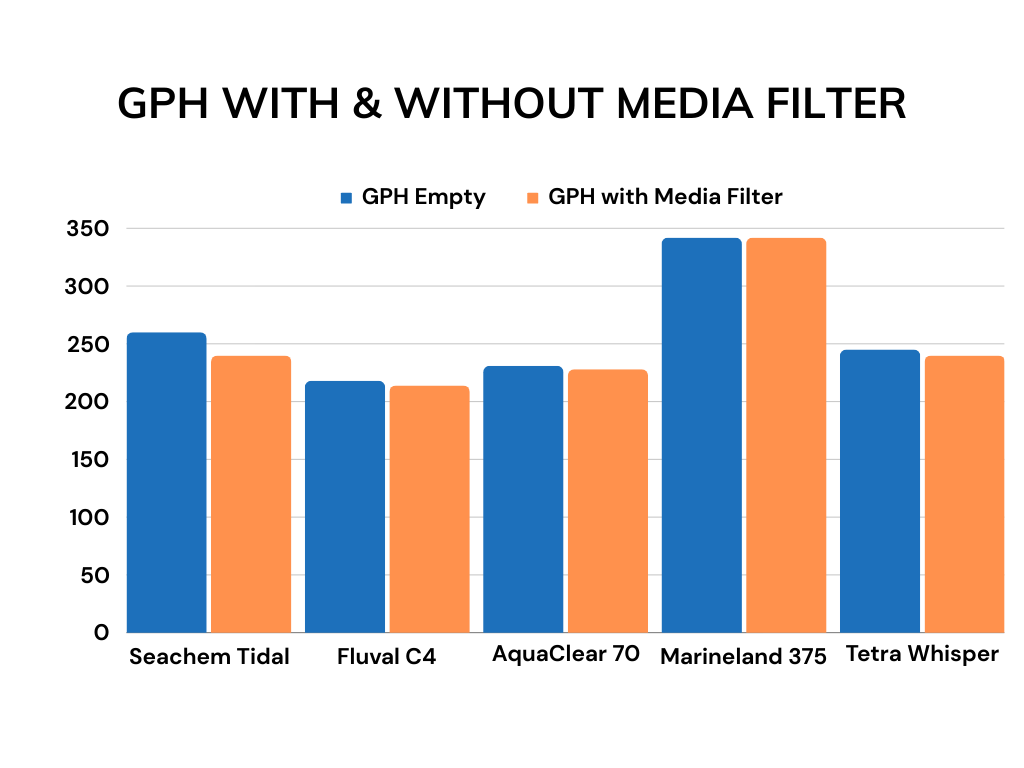
When it came to GPH, four out of the five filters were pretty darn similar.
But, the Marineland Penguin stood out from the crowd with a much higher GPH than any other brand.
But, just remember, GPH is an important consideration, but it’s not the only one.
All of these filters can comfortably pump enough water to filter a 50-60 gallon tank. Despite what the boxes say, I would go with the next size up for 75 gallon tanks.
Feature Testing: What To Look For When Choosing HOB Filter
Biomedia capacity – is there plenty of room for biomedia? This is one of the most important considerations for me. It’s even more important than GPH, in my opinion. The more fish you have, the more biomedia you need.
Priming – is the filter difficult to get started or will it gain suction on its own? Will it come back on by itself after power outages or water changes or do you have to be there to make sure the back of the filter is filled with water?
Filter media – what is the quality of the filter media that is included? I scored reusable filter media more highly and subtracted points for filters that use filter cartridges. More on that below.
I rated each of these criteria on a scale of 1 to 5, with 1 being the worst and 5 being the best.
How Ratings Were Assigned
The ratings for all of the filters are based on the points from the feature testing. So, the maximum possible score is 15 points.
A Note on Filter Cartridges and Why They Suck
There are two filters in the testing group that rely on cartridges as their filter media.
But, I want to make sure that I explain that, although cartridges make maintenance easy, I really feel that they are a low quality filter media.
I hate filter cartridges. I really, really do.
Why do I have such strong feelings about seemingly simple to use filter media?
Because they’re a total rip off, in my opinion, that are marketed as being “simple” and “easy” to aquarists when in reality they are expensive, completely unnecessary and can potentially cause problems when they’re switched out.
All a filter cartridge really is is some mechanical filter pads attached to a rigid framework with activated carbon in between them.
First off, you don’t actually need to run carbon in your filters unless you’re trying to remove something like medications or tannins from the water.
Otherwise, it’s just really expensive and doesn’t even really produce results. Carbon does not remove ammonia, nitrite, nitrate or chlorine from your water.
The whole idea that you need carbon in your filters is mostly a myth that filter manufacturers have perpetuated so they can sell you expensive filter media.
Secondly, when you throw away a filter cartridge, you’re also throwing away all of the beneficial bacteria that has grown on it.
So, you essentially throw away the things that actually help your aquarium (beneficial bacteria) so you can replace something that you really don’t need (activated carbon). And you pay tons of money throughout the year to do it!
I highly recommend ditching your filter cartridges and installing reusable filter media, especially some sort of biomedia, like ceramic rings (aka ceramic noodles), bio balls, lava rock or sintered glass.
You can also add reusable sponges to act as mechanical filter media that will catch detritus floating in the water.
And, if you’re just a super die hard carbon fan, you get reusable filter bags and fill them with carbon yourself for a fraction of the cost of cartridges.
Best Hang-on-the-Back Filters Reviewed & Compared
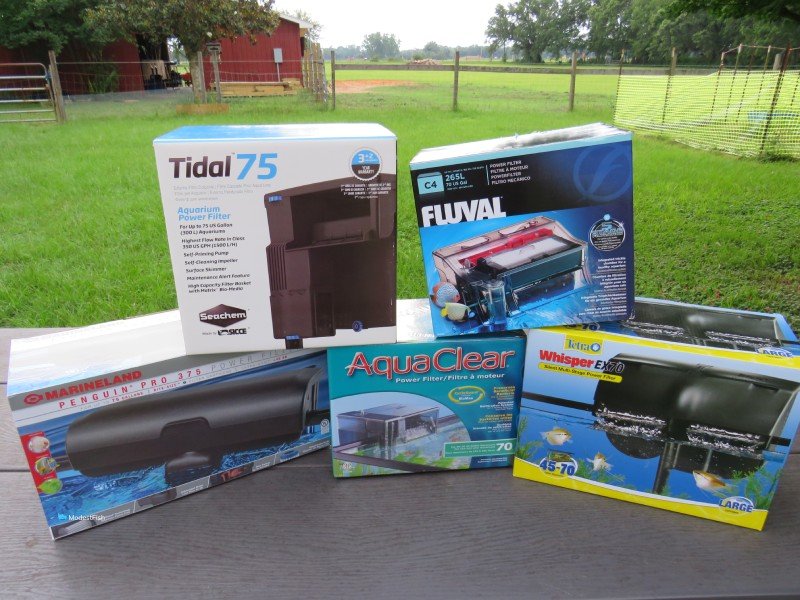
1. Seachem Tidal 75 (Top Pick)
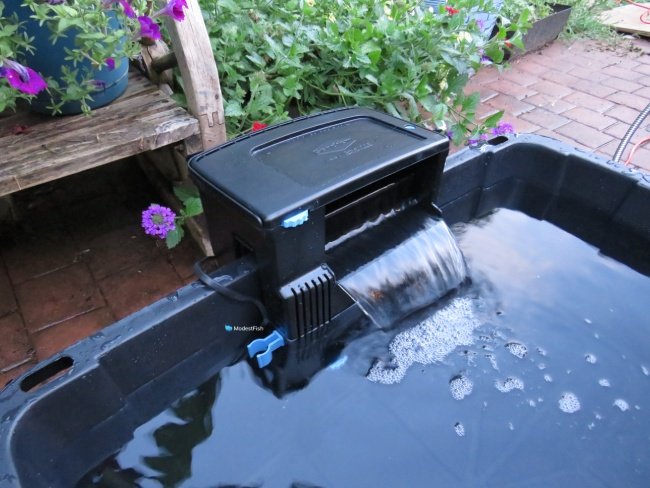
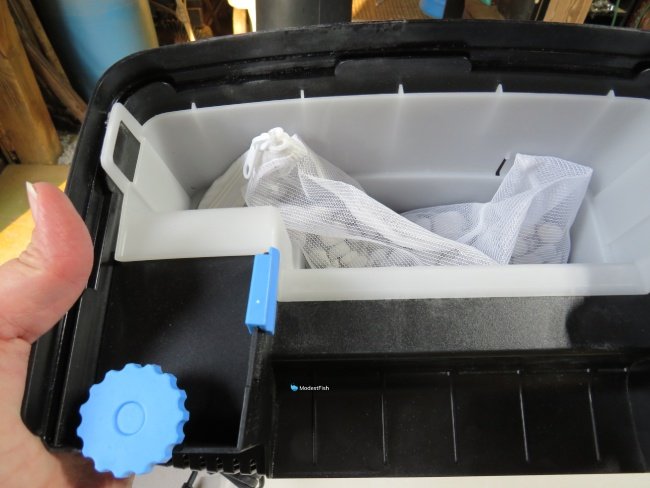
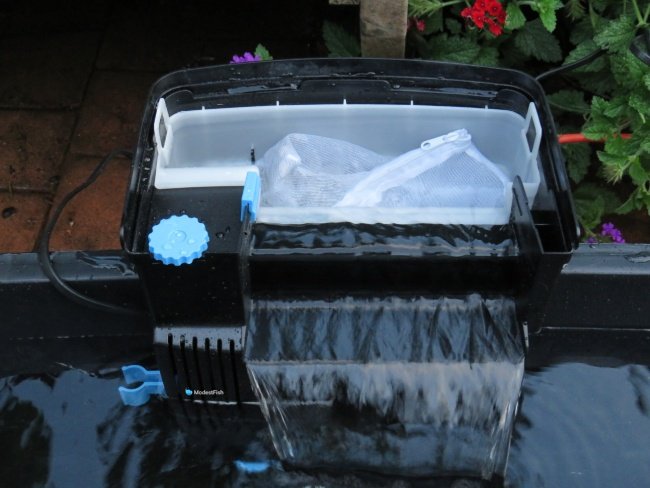
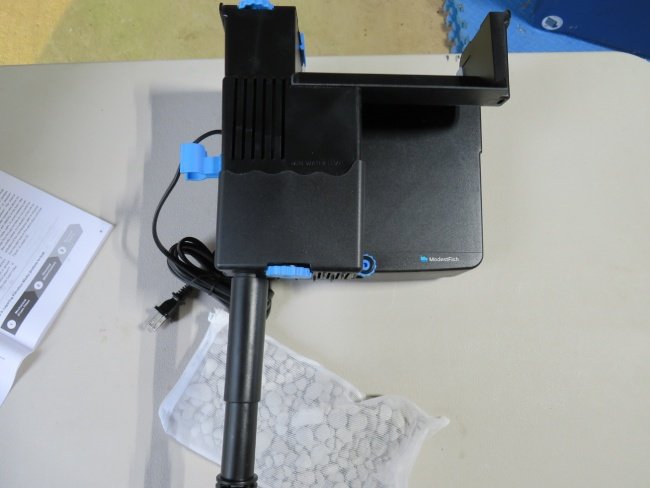
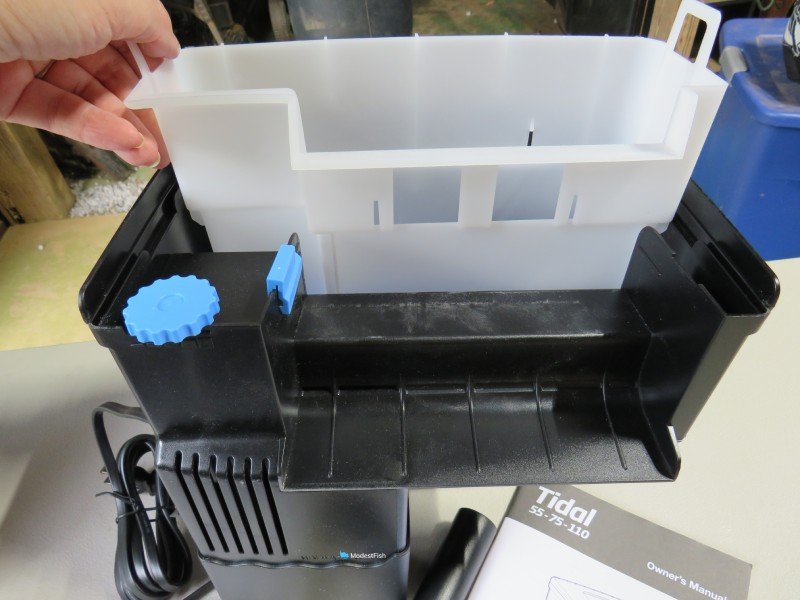
- Overall score – 14 out of 15
- Average GPH – 250
- Biomedia capacity – 5 The Seachem Tidal has an amazing amount of room for filter media. The reservoir in the back of the filter is very wide and deep, providing a large space that you can fill with whatever mechanical, biological or chemical filter media that your heart desires.
- Priming – 5 The Tidal has an internal motor, meaning the motor sits inside the tank rather than in the reservoir that hangs off the back of the tank. Filters with external motors require that you fill the reservoir with water in order for them to start pumping water. But, a filter with an internal motor, like a Seachem Tidal, can start themselves without any assistance. All you have to do is plug it in and it will start itself right up.
- Filter media – 4 This filter comes with a large reusable sponge as well as a mesh bag with Seachem Matrix biomedia. I only rate this as a 4 because you have to purchase other media yourself in order to take advantage of the large space inside the reservoir. I filled mine with extra ceramic rings to make sure there was loads of biomedia in there.
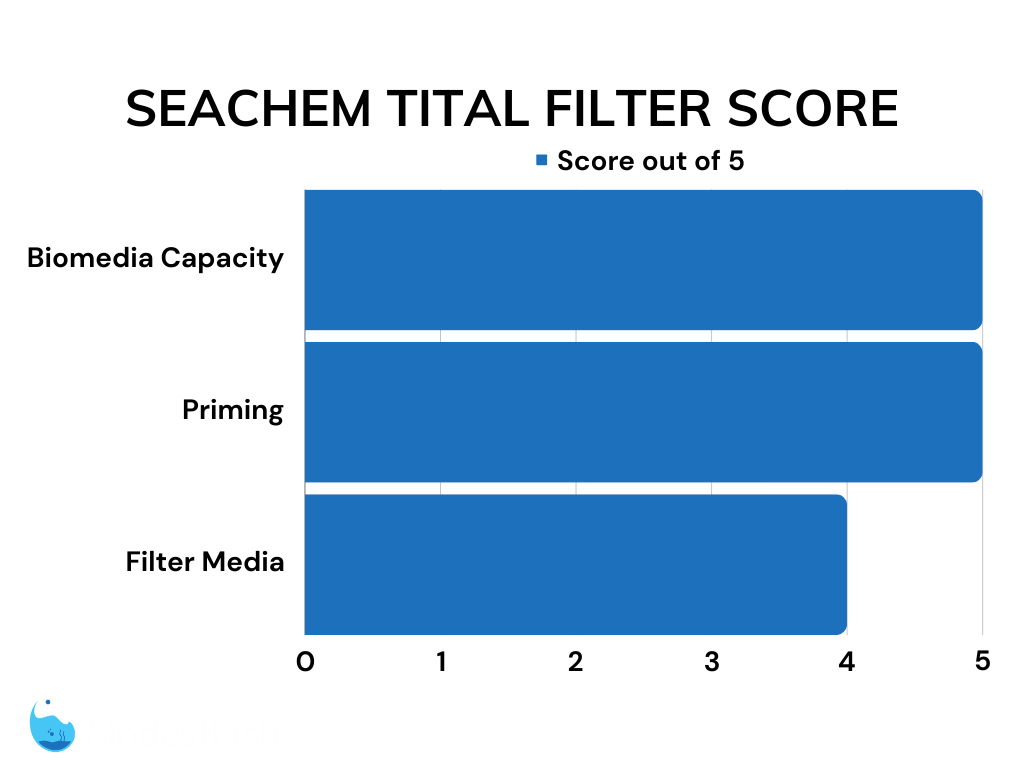
I’m a big fan of this filter. I bought a brand new one for testing, but I’ve also been running one for months on my 40 gallon (151 liter) rainbowfish tank.
I love the internal motor. It has always started right up after it’s connected to power, even after power outages and water changes.
The internal motor also makes this a very quiet filter. You really only hear the water running through the outflow and not any kind of buzzing or rattling from the filter motor.
My only real gripe about this filter is that there is no easy way to make it shrimp and/or fry safe. There are lots of aftermarket sponge pre-filters that you could get to fit over the lift tube, but this filter features a surface skimmer.
The slots on this skimmer are more than big enough for adult cherry shrimp to get through and get sucked through the motor, much less tiny baby fish. I contacted Seachem customer support about this problem and they didn’t really have a solution other than a suggestion to put some sort of mesh over the skimmer.
I guess you could come up with some sort of DIY solution and try hot gluing something over the skimmer, but I have not tested this out.
But, if you don’t have shrimp or fry in your tank, this is pretty much the perfect filter.
It’s very easy to do monthly maintenance on a Seachem Tidal. All the filter media is housed inside a big basket so you can just pull the whole thing out at once. The basket even snaps onto the filter lid so that you can carry it through the house without dripping on the floor. Pretty darn cool.
Overall, I love this thing and highly recommend it for the majority of aquarium applications.
Pros:
- No priming needed
- Huge filter media capacity
- Quiet running
- Easy maintenance
Cons:
- Difficult to make shrimp/fry safe
- You may need to pick up additional filter media

Last update on 2024-04-19 / Commissions Earned / Images from Amazon Product Advertising API
See our in-depth Seachem Tidal Filter Review
2. Fluval C4 HOB Filter (Runner up)
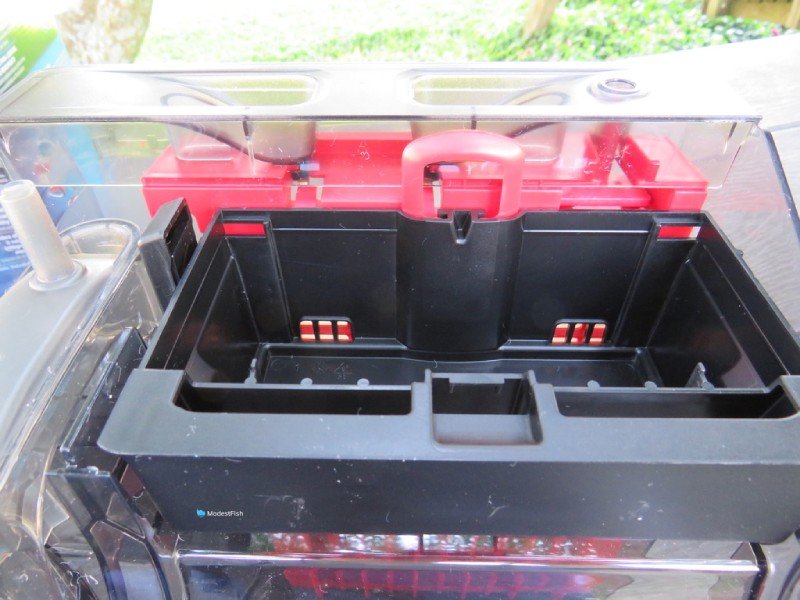
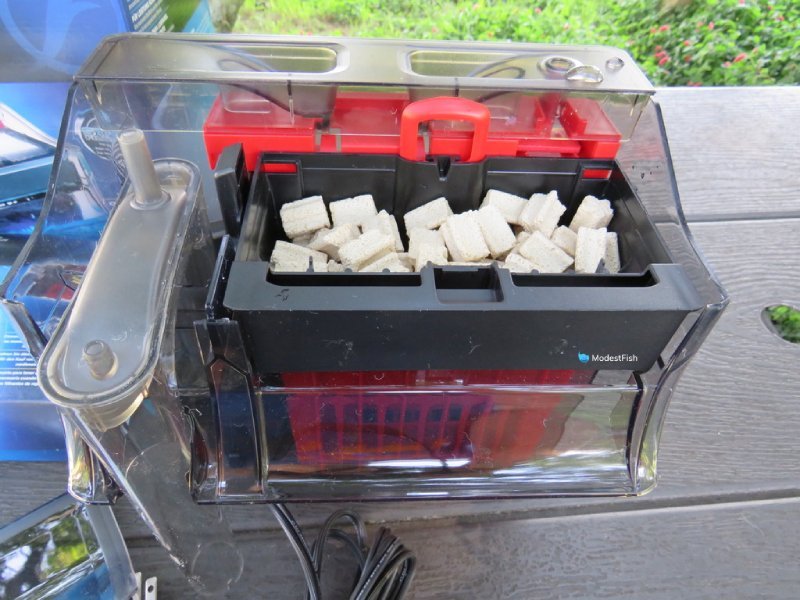
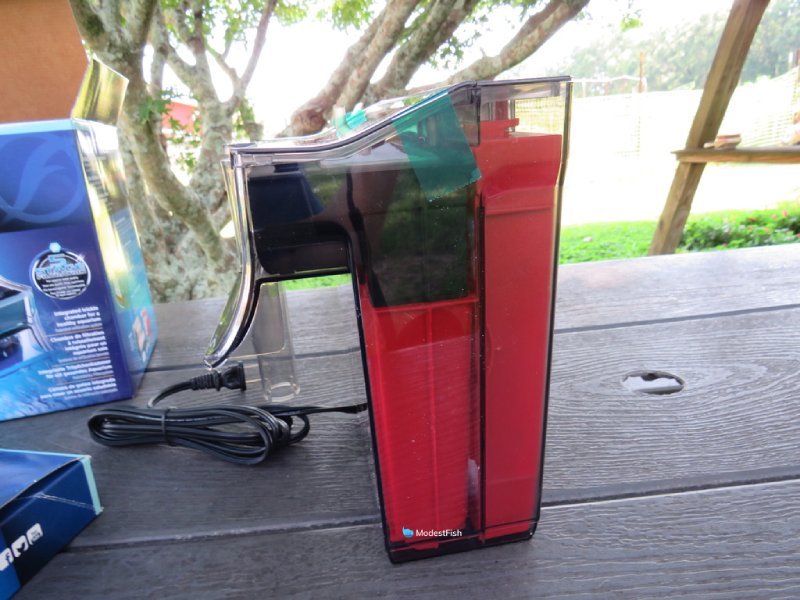

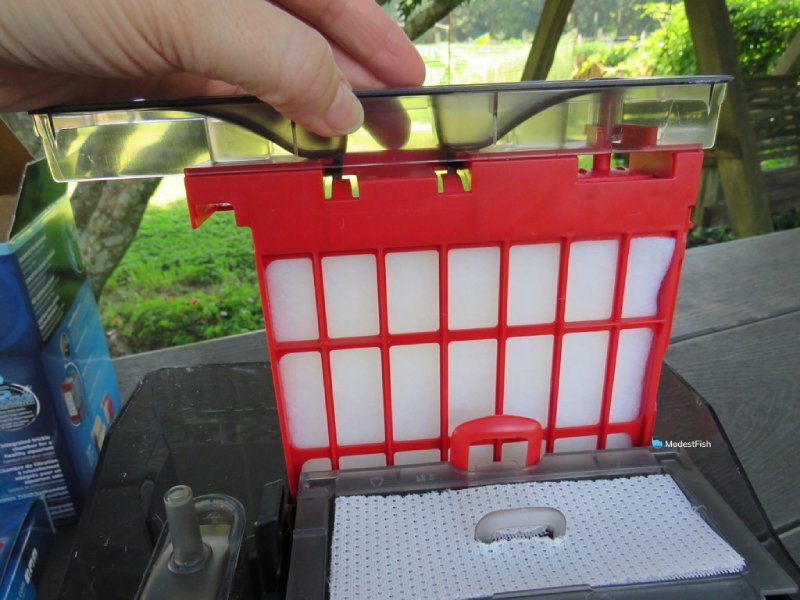
- Overall score – 11 out of 15
- Average GPH – 216
- Biomedia capacity – 5 There is plenty of room for biomedia in this filter. Water is dripped through a special screen (that’s also another form of biomedia) onto ceramic media in its own special chamber. You can also fit even more biomedia into this filter if you skip the carbon and use that compartment for more ceramic media.
- Priming – 1 The Fluval C4 has an external motor that will need priming to start up. It is fairly simple to prime, but you will need to check on it after power outages to ensure it’s started back up.
- Filter media – 5 This filter comes with high quality filter media. There is a huge reusable filter sponge for catching debris and keeping your water clear. It’s easy to pull this out and clean it off. There is also a fairly large compartment filled with ceramic rings. A large mesh bag of activated carbon is included. If you’re not worried about running carbon, the area dedicated to carbon can be filled with a mesh bag of the biomedia of your choice.
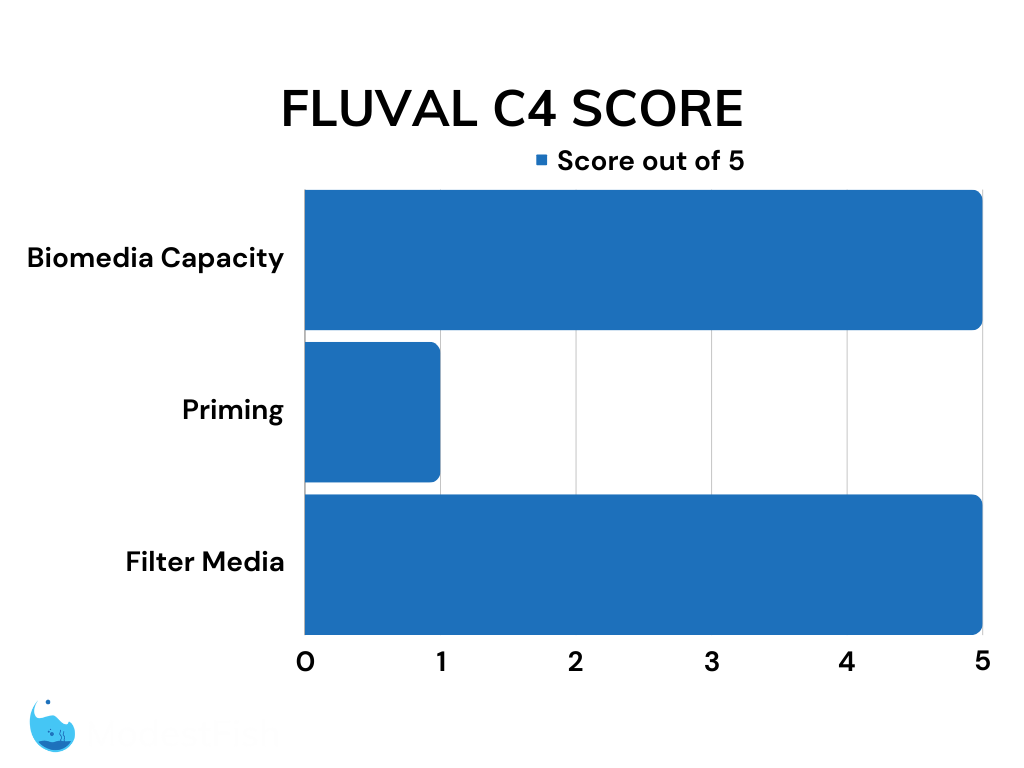
OK I’ve just got to say, this thing is super cool. Fluval has put a lot of thought into designing this filter.
Everything in the filter has its own compartment, like the sponge, the biomedia and the carbon. It all snaps together to keep everything in place and each compartment has its own handle so you can take each one out separately from the others. It’s easy to pull out any compartment you want for cleaning and maintenance. Pretty awesome.
I know this is subjective, but it also just looks really cool. It all seems kind of sophisticated and futuristic.
The only downside to this filter is that it has an external motor so you do have to prime it to get it started.
Pros:
- Innovative design that puts media into its own compartment
- Easy maintenance
- Looks awesome
- Large space for biomedia
Cons:
- Has an external motor that requires priming

Last update on 2024-04-18 / Commissions Earned / Images from Amazon Product Advertising API
Read the full in-depth Fluval C4 Power Filter Review here
3. Aquaclear 70 HOB Filter (Best For Shrimp Tanks)
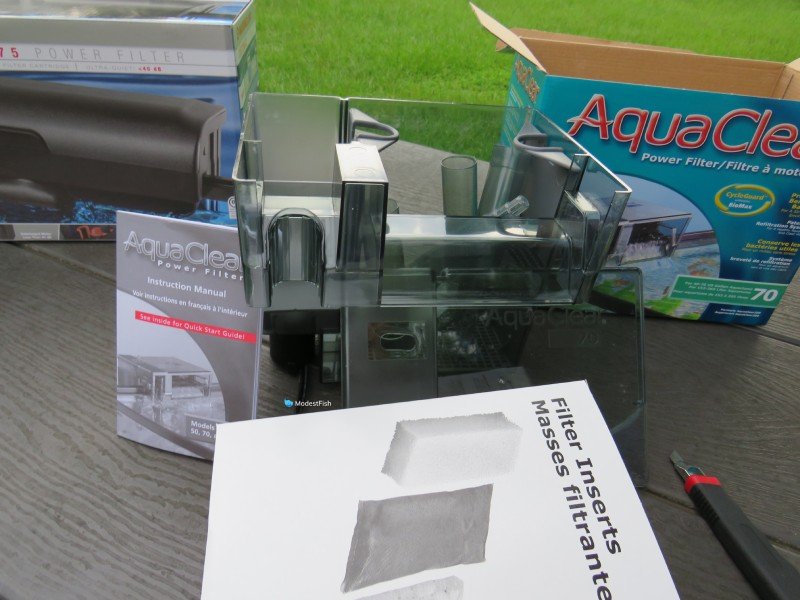
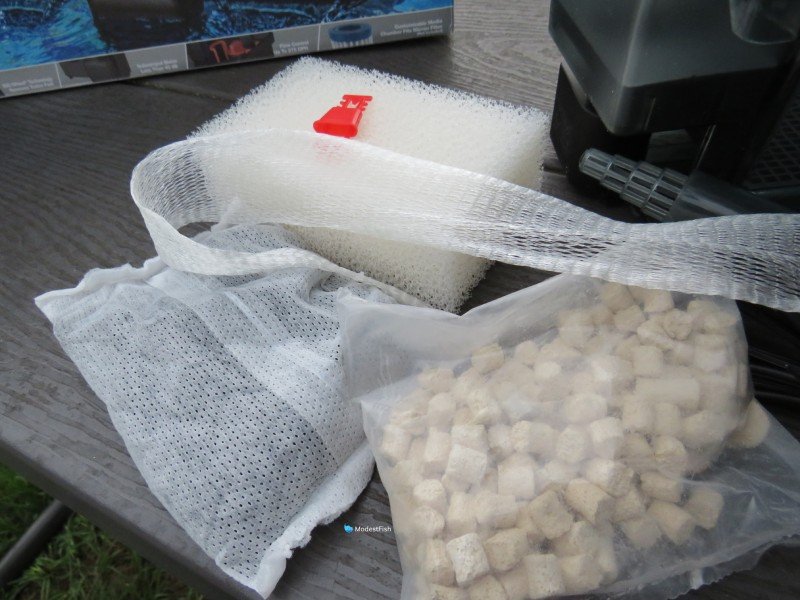
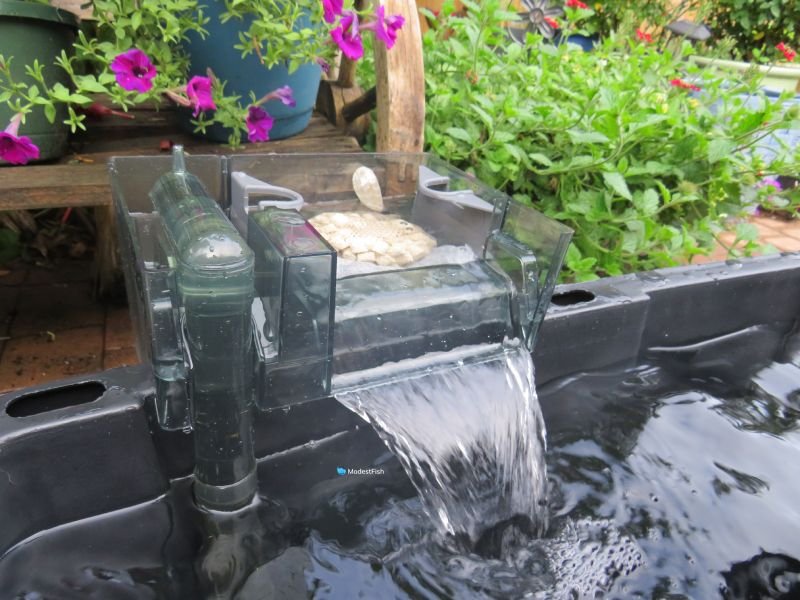
- Overall score – 11 out of 15
- Average GPH – 229
- Biomedia capacity – 5 This filter has a large space for biomedia. If you skip adding the carbon, you can fit even more biomedia into the reservoir.
- Priming – 1 You will need to prime this filter to get it started. Also, make sure to check on this filter after any power outages. Sometimes it can be touchy about coming back on once it has power.
- Filter media – 5 The AquaClear has high quality filter media, including mechanical, biological and chemical. The sponge and ceramic biomedia can be used for several years, if not more.
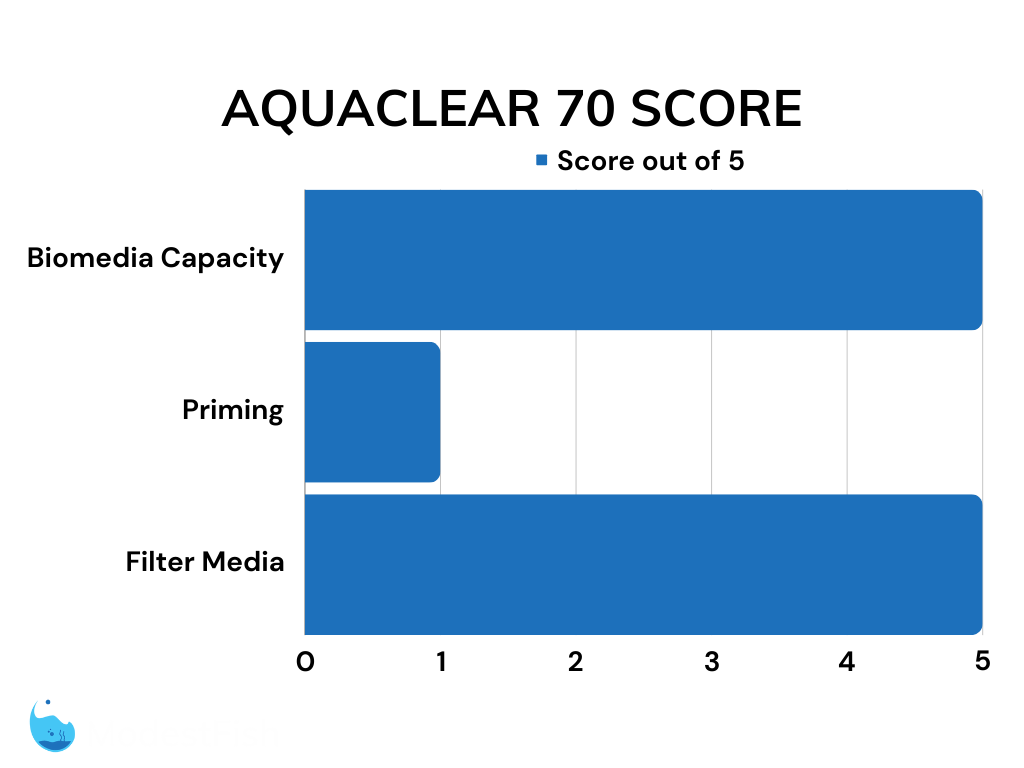
I have a lot of experience with this particular filter. I have used AquaClears for several years now and two of my tanks are running AquaClears. At one time, it was the only filter that I used.
These days, I also have Fluval and Seachem filters, but two of my tanks are still running this exact model of filter.
I love how much room there is for biomedia in the back of this filter. Not quite as much as the Seachem Tidal, but if you skip putting carbon in the filter, you can double the amount of biomedia that it comes with.
The media is very high quality. There’s a large reusable sponge for mechanical filtration, a mesh bag with ceramic biomedia and a large bag of activated carbon. I’ve run several successful tanks for years on just the sponge and ceramic media that comes with the filter.
It’s fairly easy to make this filter shrimp safe. Just adding an aftermarket sponge pre-filter will keep shrimp from taking a ride through the motor. Plus, your shrimp will spend all day on the surface of the pre-filter eating algae and gunk off it.
I have used this filter with a pre-filter to run my 40 gallon (151 liter) shrimp tank for several years now and it has been great.
Now, there can be some downsides to this filter. You do have to prime it, and sometimes, it can be a pain to get it started after a water change.
If it won’t start up, I usually have to twist off the motor and clean out the impeller well, even if it seems like there really isn’t any gunk in there. But, this is fairly easy to do and will get this filter chugging along again.
Also, over time, the filter can develop a rattle because the lid vibrates. This can be pretty annoying. My workaround is to put a can of fish food or a paperweight on top of the lid. Just a little bit of weight keeps the lid from vibrating noisily.
Not the most sophisticated workaround, I’ll grant you, but it’s effective.
Maintenance is fairly easy. All of the filter media sits on top of this two-sided basket thingy. So it’s easy to get the media out, but since the basket only has two sides, it can be precarious and a bit messy when you pull it out. I recommend having a bucket ready so you can pull the media out and immediately get it into the bucket.
It’s not hard at all, it’s just not as nice and neat as the nifty filter basket on the Tidal that snaps onto the lid.
Overall, I highly recommend this filter. It’s not quite as fancy dancy as the Seachem or the Fluval, but I can say without a doubt, it’s a solid little workhorse that should run for years.
Just one note, the manufacturer recommends that you change out the sponge and ceramic media once a year, but I wholeheartedly disagree. These should only be changed out if they are falling apart. In my experience, they are good for the lifetime of the filter, if not longer.
Pros:
- Lots of room for biomedia
- Easy to make shrimp safe
- Easy maintenance
- Reliable, solid performer
- Excellent filter media
Cons:
- Requires priming
- Can develop a rattle over time
- Sometimes tricky to get it started after a water change

Last update on 2024-04-18 / Commissions Earned / Images from Amazon Product Advertising API
See our in-depth AquaClear Filter Review
4. Marineland Penguin 375 HOB Filter
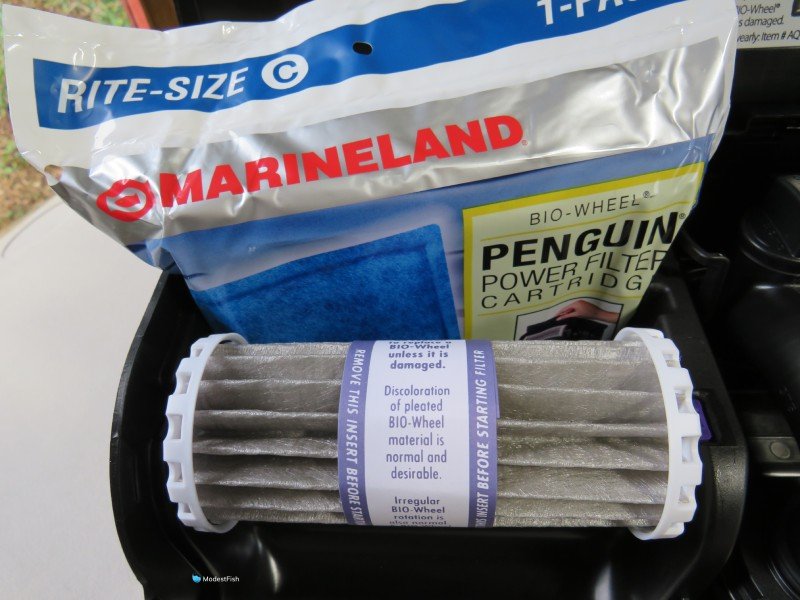
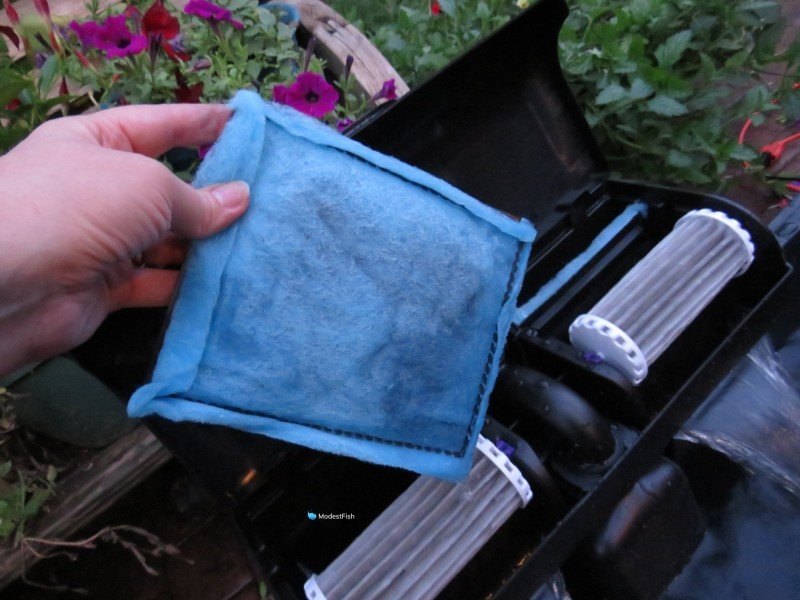
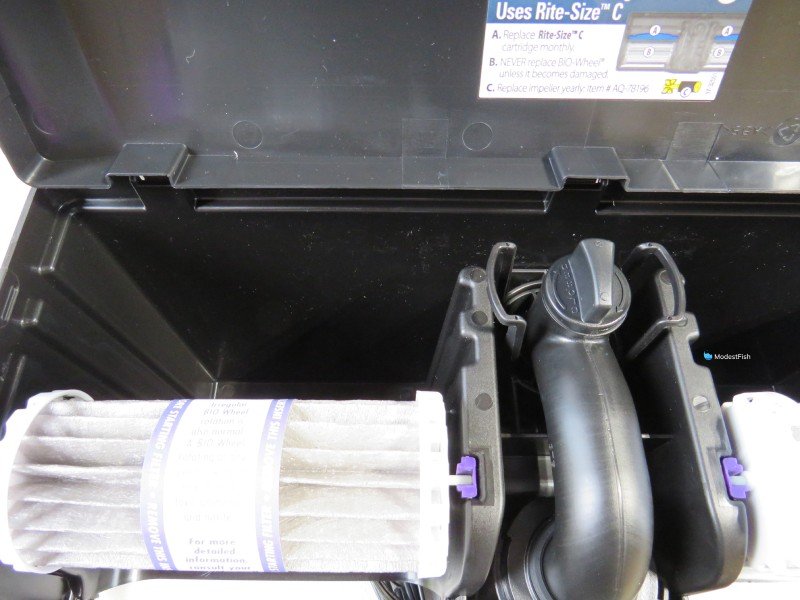
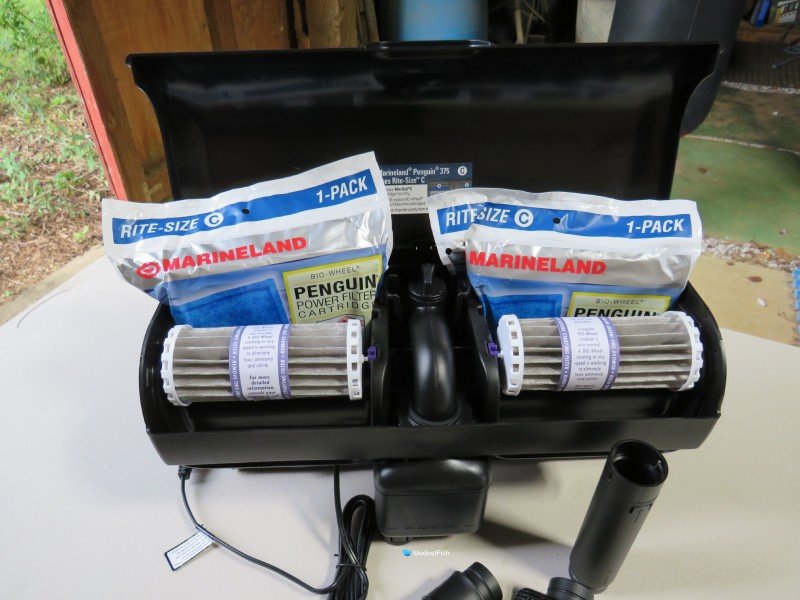

- Overall score – 9 out of 15
- Average GPH – 342
- Biomedia capacity – 3 Marineland does have its patented Bio-Wheels that are meant to act as biomedia. But this is a small amount of biomedia space compared to filters that you can fill with half a pound or more of ceramic media.
- Priming – 5 Priming this filter is a breeze. It has an internal motor that is a beast! Just plug it in and it will start pumping away.
- Filter media – 1 I’m not a huge fan of the biomedia options for this filter. You get the Bio-Wheels but this filter also relies on cartridges. I would much prefer reusable sponges for mechanical filtration and other biomedia materials besides the Bio-Wheels, like ceramic rings. If you change out the cartridges so you have fresh carbon, you’ll be throwing away all of the beneficial bacteria that grows on the outside of the cartridge.
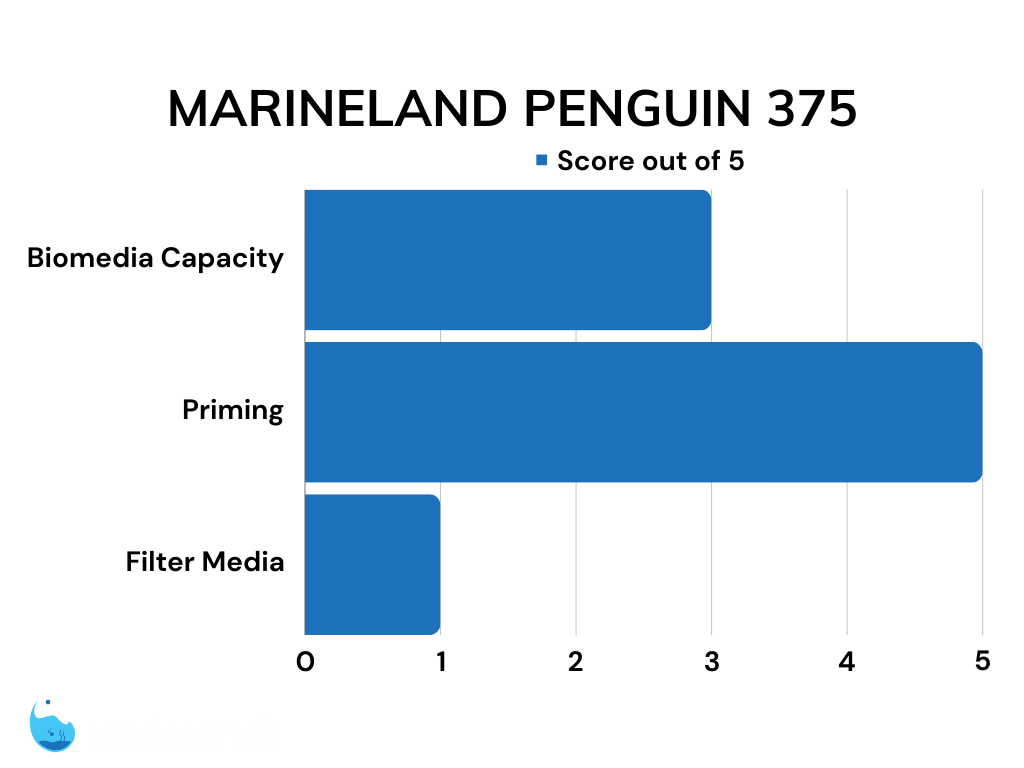
I really want to like this filter. But, I just can’t get past the whole cartridge thing. The carbon will get gunked up in less than a month and then it won’t be doing you any good.
Also, since the emphasis is on cartridges being disposable, they are not made in a way so that they’re easy to clean. There’s no good way to get the gunk off them without using a garden hose. But then, the beneficial bacteria would be killed by the chlorine or chloramine in the tap water (unless you’re using well water), so there’s no point reusing the cartridge anyway.
I wholeheartedly wish that Marineland would redesign this filter so it uses reusable sponges and additional forms of biomedia. Which, they’re never going to do because they make so much money off the cartridges.
But, this thing is a beast with a strong motor that chugs out more GPH than any of the others and it doesn’t need priming since it’s got an internal motor. I think it would be my favorite if it just wasn’t for the cartridges.
You can also feel how heavy duty this filter is when you handle it. It’s obvious that it has solid construction made from high quality plastic.
Pros:
- Easy priming
- Highest GPH among the 5 filters tested
- Quiet running
- Solid, sturdy construction
Cons:
- Uses cartridges
- Limited biomedia space other than biowheels
- No reusable mechanical media

Last update on 2024-04-18 / Commissions Earned / Images from Amazon Product Advertising API
Read our full in-depth review of the Marineland Penguin Power Filter
5. Tetra Whisper EX 70 HOB Filter

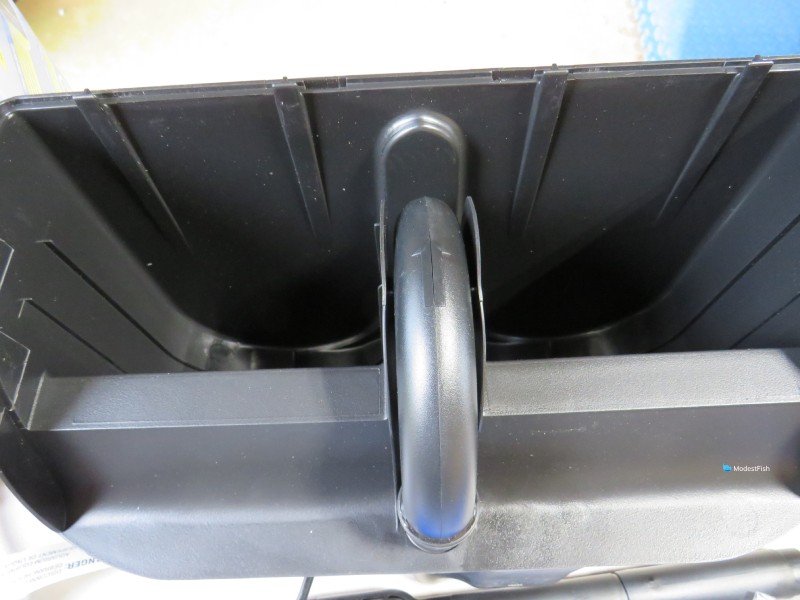
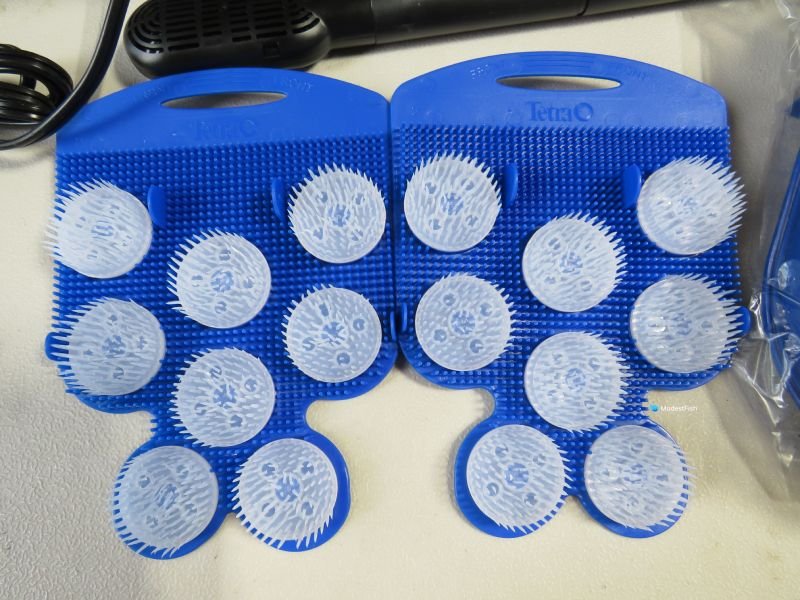
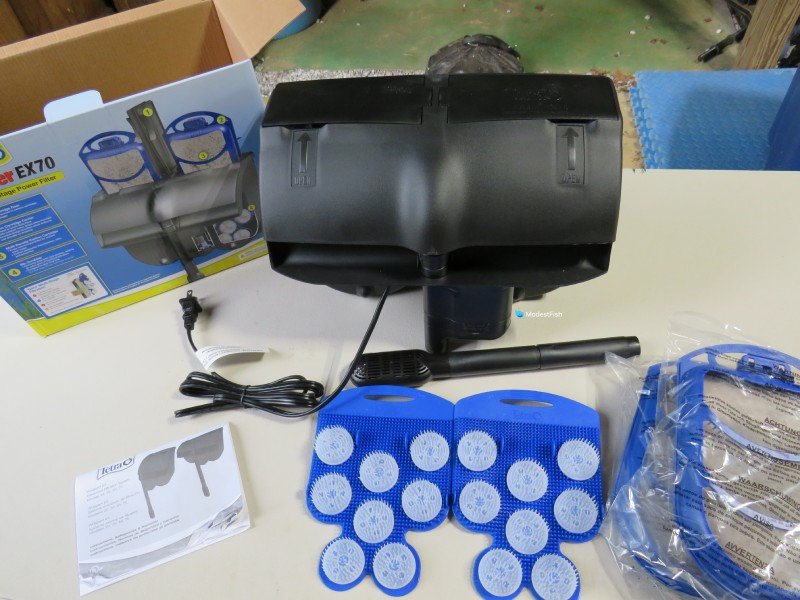
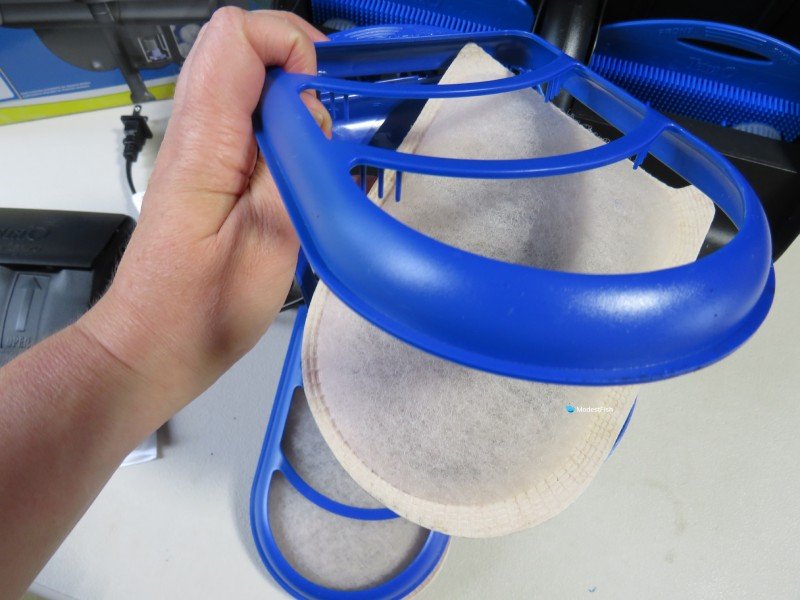
- Overall score – 9 out of 15
- Average GPH – 243
- Biomedia capacity – 3 This filter utilizes cartridges and the reservoir has been made as slim as possible. It does have dedicated biomedia in the form of two plastic screens that have what look like circles of bristles. I do know from experience that these bristles do house beneficial bacteria, but there could be a lot more surface area if there was additional media.
- Priming – 5 No need to prime this filter. It starts on its own very well. Just plug it in and it will start chugging along.
- Filter media – 1 Again, I’m not too impressed with the filter media since it mainly focuses on cartridges. The plastic biomedia can support moderate stocking, but I would not try to use this in a heavily stocked tank. I would have been much happier with reusable mechanical media and more substantial biomedia.
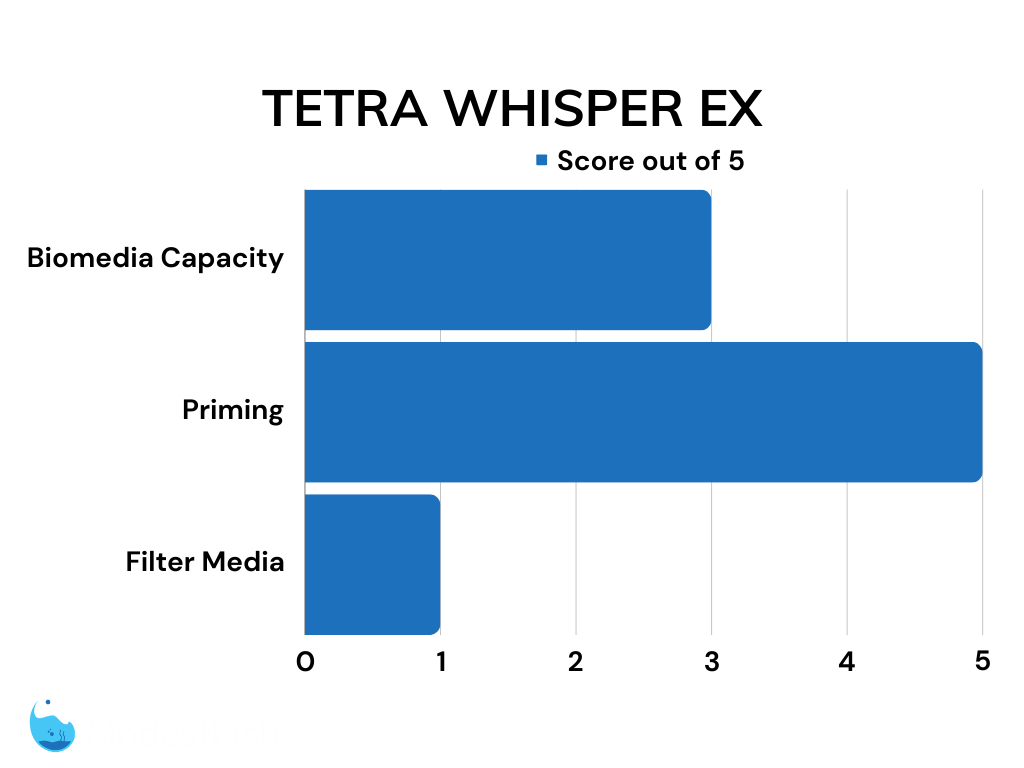
This was my least favorite of all the filters.
First off, I know this isn’t terribly impartial or scientific, but this filter just feels cheaply made when you’re handling it. The Marineland at least feels sturdy and substantial. The plastic on this Tetra has the tendency to bow a bit when you’re installing it.
It’s also very easy for the lift tube to fall off. We had to keep putting it back on the filter over and over when we were installing and testing it.
I’ve been using one of these that someone gave me for free for several months now. The lift tube comes off multiple times every time we do water changes and we keep having to mess with it to get it to stay put. It’s annoying.
Also, I think we’ve definitely established already that I really don’t like filter cartridges, and that’s what this filter uses.
I can say from experience that the included biomedia is serviceable, but just barely. I’ve had trouble with it being able to keep up with higher stocking levels.
I do give it credit for priming. There’s no need to make a big fuss when you’re trying to get this filter up and running.
But, Tetra has made the back of the filter so slim that even if you ditch the cartridges, it’s hard to fit enough biomedia in this filter, in my opinion.
Pros:
- Easy priming
Cons:
- Uses cartridges
- Not enough space for biomedia
- Feels cheap and flimsy
- Lift tube falls off at the slightest touch

Last update on 2024-04-18 / Commissions Earned / Images from Amazon Product Advertising API
Read out full in-depth review of the Tetra Whisper EX70
Top Pick

For me, the clear winner of this head-to-head challenge is the Seachem Tidal. I love the features, like the internal motor and the filter basket that snaps onto the lid. It’s so easy to get it up and running and there’s just loads of room for biomedia.
If it was just easier to make it shrimp safe, I would call it the most perfect hang-on-the-back filter ever.
If you are wanting to use one of these for a shrimp tank, I highly recommend getting an AquaClear 70 and adding a sponge pre-filter. I don’t like the filter media basket as much on the AquaClear, but that’s just nitpicking.
And don’t discount the Fluval C4. The innovative design is unique and really well laid out. Maintenance is a breeze since you can pull each kind of media out individually so easily.
I might have even rated this above the Tidal, if it had an internal motor. But, priming isn’t hard with the C4 and it’s a great filter.
| Preview | Product | |
|---|---|---|

|
SeaChem – Large Aquarium Fish Tank Filter, Tidal 75 Gallon (300 Liters) by Sicce | Buy on Amazon |

|
Fluval C4 Power Filter, Fish Tank Filter for Aquariums up to 70 Gal. | Buy on Amazon |

|
AquaClear 70 Power Filter, Fish Tank Filter for 40- to 70-Gallon Aquariums, Black | Buy on Amazon |

|
MarineLand Penguin PRO 375 Power Filter, Multi-Stage Aquarium Filtration for Up to 75 Gallons | Buy on Amazon |

|
Tetra Whisper EX 70 Filter For 45 To 70 Gallon aquariums, Silent Multi-Stage Filtration, WHITE | Buy on Amazon |
Last update on 2024-04-18 / Commissions Earned / Images from Amazon Product Advertising API
FAQs For HOB Filters:
What is a Hang-on-the-Back Filter?
There are lots of different kinds of filters in the aquarium hobby: canister filters, sponge filters, corner filters, internal filters, wet dry filters, etc.. Each has their own defining features as well as pros and cons.
Hang-on-the-back filters do exactly what the name implies. They hang over the back wall of the aquarium.
They all have a “lift tube” that goes down into the tank itself. A motor sucks water up through this lift tube and into the body of the filter, known as the reservoir.
The water passes through the different kinds of filter media in the reservoir and then it cascades back into the tank through an outflow on the front of the filter.
Hang-on-the-backs are really popular because they don’t take up much space, are easy to install and use, and are generally more economical than other power filters, like canisters.
The biggest drawback to this style of filter is that there is often limited space for biomedia, and therefore, beneficial bacteria.
Nonetheless, hang-on-the-backs are the most common kind of filter that you’ll see used in hobbyists’ tanks.
Do You Even Need a Filter for Your Aquarium?
YES!!
Filters are one of the most important parts of any aquarium. Actually, without a filter, most kinds of fish will die within a few days.
Let me explain.
Filters do more than just pump water around your tank. Don’t get me wrong, that’s important, but that’s not the only reason aquarists use filters.
Fish put off urine and feces into the water pretty much all the time. Gross, but also, totally true.
Those wastes accumulate in the aquarium and start to break down. As they rot, they put off ammonia (NH3). Without a filter, the wastes keep breaking down, the ammonia continues to build, and eventually, the water becomes so toxic that it will kill any fish swimming in it.
Filters fix this problem. Inside of aquarium filters there is a special kind of filter media, called biomedia. Biomedia is the most important part of a filter because that is where beneficial bacteria grow that process wastes from the water column.
These beneficial bacteria eat ammonia and turn it into something called nitrite (NO2 -1). Nitrite is also a toxic substance, but luckily, it’s quickly eaten up by the bacteria and turned into something called nitrate (NO3-).
Nitrate is much less toxic than ammonia or nitrite, so it can be allowed to build up in the tank in between weekly water changes.
This process of ammonia being broken down into nitrate is called the Aquarium Nitrogen Cycle. For more detailed information about this, please see our comprehensive article here.
Breaking down these toxins is critical if you want to keep your fish alive.
There are lots of different materials that can be used as biomedia, like ceramic, sintered glass or bioballs, but they all have one thing in common: lots and lots of little nooks and crannies that bacteria like to live in.
All those little pockets greatly increase the surface area inside the filter so that there’s enough room to grow a bacterial colony big enough to keep up with fish waste as it’s produced.
And the more fish you have in a tank, the more room you need for beneficial bacteria to grow.
There just is not enough surface area inside the tank itself to support all of the bacteria you’ll need to keep your tank water clean. So, you need a filter, to house the beneficial bacteria and to constantly pump water over them so all the waste gets to them and they can transform it to nitrate.
Having a filter on your tank is critical, but you will still need to do some cleaning to maintain your tank. It’s best to perform 25%-50% water changes every week.

I enjoyed your article, especially the flow rates. I am a huge proponent of Penguin filters and was happy to see your info about their flow rates.
In my modestly sized fish room I use two Penguin 350’s, two Penguin 200’s, four Penguin 150’s and two Penguin 100’s. I also use a Tidal 110, two Topfin 75’s and one Topfin 40.
If you pack the Penguin media box with a piece of 30 PPI foam and allow a 1/2″ gap at the back of the sponge so the water can access the entire sponge surface, the Penguins are the best HOB filters around.
If you would like I can sen d you a pic of how to place a 30 PPI sponge to make Penguin filters AWESOME!
This is the best comparison of HOB’s I’ve seen in years. Truthful info that has me thinking very hard which one to choose. Seachem or Fluval, now i need to pick one
Hi Katherine! Good review on the most popular HOB Filters. I have an AquaClear 2000 (same capacity as their current Model 110) that I have had on my 55-gallon since 1984!! 38-years and still no issues…not bad, huh? Anyhoo, a lot of folks complain that the AquaClear doesn’t prime easily after a power outage but I believe this is only if the water level in the aquarium is too low. I’ve always kept the water level just below where the water come from the filter and my filter never has an issue priming again. Luckily my Model 2000’s lid doesn’t rattle like the current models because the old lid doesn’t just drop into place. I’m too stupid to explain how it works but there are 3-parts on the back of the lid that attaches themselves onto the body of the filter for a tight fit. Not familar with the Seachem but can you replace assorted parts (motor, rotor, etc.) as with the AquaClear models? For old timers who may remember, the old AquaClears were an Amber color and not Clear as now. Again, I appreciate your reviews BUT should my current filter die before I do, I’m replacing it with an AquaClear!!
Hi, Katherine, How would the Fluval filter work with shrimp? (It’s the only one you didn’t mention anything about shrimp on). I think I would really like this filter if it can easily be made shrimp-safe). Thanks for the reviews, they are very helpful!
Hi Tim, we actually have a guide here focused on filters for shrimp https://modestfish.com/best-filter-shrimp-tank/